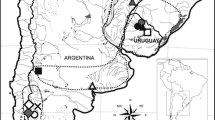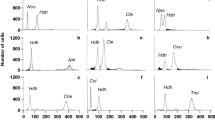Abstract
Genome size variation in a taxonomic group reflects evolutionary processes. DNA contents of Ophiopogoneae (40 populations of 31 species) were estimated by flow cytometry. Ploidy levels of Ophiopogon (ten species), Liriope (two species), and Peliosanthes (three species) were determined based on the DNA contents. The genus Peliosanthes showed significant larger genome sizes than Ophiopogon (P < 0.01), and Ophiopogon also significant larger than Liriope (P < 0.05). Intraspecific variation in genome size was mainly chromosome difference. The ITS sequence phylogeny splitted Ophiopogon into two clades, clade I comprising sect. Ophiopogon with diploids and tetraploids, and clade II including transitional species and sects. Ophiopogon and Peliosanthoides with diploids. The trend seemed to increase in genome size from Ophiopogon sect. Peliosanthoides (13.45 pg) to Ophiopogon sect. Ophiopogon (14.27 pg). Polyploidization may be evolutionary direction of Ophiopogon. Our results also suggested that the ‘increase’ hypothesis for genome size evolutionary may hold true in the genus Ophiopogon.


Similar content being viewed by others
References
Arumuganathan K, Earle ED (1991) Estimation of nuclear DNA content of plants by flow cytometry. Plant Mol Biol Rep 9:229–233
Bainard JD, Husband BC, Baldwin SJ, Fazekas AJ, Gregory TR, Newmaster SG, Kron P (2011) The effects of rapid desiccation on estimates of plant genome size. Chromosome Res 19:825–842
Barakat A, Carels N, Bernardi G (1997) The distribution of genes in the genomes of Gramineae. P Natl Acad Sci USA 94:6857–6861
Bennett MD (1972) Nuclear DNA content and minimum generation time in herbaceous plants. P R Soc B Biol Sci 181:109–135
Bennett MD (1973) Nuclear characters in plants. Brookhaven Symp Biol 25:344–366
Bennett MD, Leitch IJ (2011) Nuclear DNA amounts in angiosperms: targets, trends and tomorrow. Ann Bot 107:467–590
Bennett MD, Bhandol P, Leitch IJ (2000) Nuclear DNA amounts in angiosperms and their modern uses-807 new estimates. Ann Bot 86:859–909
Bennetzen JL (2002) Mechanisms and rates of genome expansion and contraction in flowering plants. Genetica 115:29–36
Bennetzen JL, Ma J, Devos KM (2005) Mechanisms of recent genome size variation in flowering plants. Ann Bot 95:127–132
Besnard G, Garcia-Verdugo C, Rubiodecasas R, Treier UA, Galland N, Vargas P (2008) Polyploidy in the olive complex (Olea europaea): evidence from flow cytometry and nuclear microsatellite analyses. Ann Bot 101:25–30
Bharathan G (1996) Reproductive development and nuclear DNA content in angiosperms. Genome 39:379–394
Bharathan G, Lambert G, Galbraith DW (1994) Nuclear DNA content of monocotyledons and related taxa. Am J Bot 81:381–386
Bureš P, Wang YF, Horová L, Suda J (2004) Genome size variation in central European species of Cirsium (Compositae) and their natural hybrids. Ann Bot 94:353–363
Chrtek J, Zahradniček J, Krak K, Fehrer J (2009) Genome size in Hieracium subgenus Hieracium (Asteraceae) is strongly correlated with major phylogenetic groups. Ann Bot 104:161–178
Comeron JM (2001) What controls the length of noncoding DNA? Curr Opin Genet Dev 11:652–659
Doležel J, Greilhuber J, Lucretti S, Meister A, Lysák MA, Nardi L, Obermayer R (1998) Plant genome size estimation by flow cytometry: inter-laboratory comparison. Ann Bot 82:17–26
Doležel J, Greilhuber J, Suda J (2007) Estimation of nuclear DNA content in plants using flow cytometry. Nat Protoc 2:2233–2244
Galbraith DW, Harkins KR, Maddox JM, Ayres NM, Sharma DP, Firoozabady E (1983) Rapid flow cytometric analysis of the cell cycle in intact plant tissues. Science 220:1049–1051
Greilhuber J (1986) Severely distorted Feulgen-DNA amounts in Pinus (Coniferophytina) after non additive fixations as a result of meristematic self-tanning with vacuole contents. Can J Genet Cytol 28:409–415
Greilhuber J (1988) ‘‘Self-tanning’’—a new an important source of stoichiometric error in cytophotometric determination of nuclear DNA content in plants. Plant Syst Evol 158:87–96
Greilhuber J (1998) Intraspecific variation in genome size: a critical reassessment. Ann Bot 82:27–35
Greilhuber J (2005) Intraspecific variation in genome size in angiosperms: identifying its existence. Ann Bot 95:91–98
Greilhuber J, Obermayer R (1997) Genome size and maturity group in Glycine max (soybean). Heredity 78:547–551
Greilhuber J, Temsch EM, Loureiro JCM (2007) Nuclear DNA content measurement. In: Doležel J, Greilhuber J, Suda J (eds) Flow cytometry with plant cells: analysis of genes, chromosomes and genomes. Wiley, Weinheim, pp 67–101
Grover CE, Wendel JF (2010) Recent insights into mechanisms of genome size change in plants. J Bot. doi:10.1155/2010/382732
Hall TA (1999) BioEdit: a user-friendly biological sequence alignment editor and analysis program for Windows 95/98/NT. Nucleic Acids Symp Ser 41:95–98
Hall S, Dvorak WS, Johnston JS, Price HJ, Williams CGE (2000) Flow cytometric analysis of DNA content for tropical and temperate new world pines. Ann Bot 86:1081–1086
Hanson L, McMahon KA, Johnson MAT, Bennett MD (2001) First nuclear DNA C-values for 25 angiosperm families. Ann Bot 87:251–258
Huang H, Tong Y, Zhang QJ, Gao LZ (2013) Genome size variation among and within Camellia species by using flow cytometric analysis. PLoS ONE 8:e64981
Huelsenbeck JP, Ronquist R (2001) MRBAYES: bayesian inference of phylogenetic trees. Bioinformatics 17:754–755
Kolář F, Lučanová M, Těšitel J, Loureiro J, Suda J (2012) Glycerol-treated nuclear suspensions—an efficient preservation method for flow cytometric analysis of plant samples. Chromosome Res 20:303–315
Lattier JD, Ranney TG, Fantz PR, Avent T (2014) Identification, nomenclature, genome sizes, and ploidy levels of Liriope and Ophiopogon Taxa. HortScience 49:145–151
Leitch IJ, Chase MW, Bennett MD (1998) Phylogenetic analysis of DNA C-values provides evidence for a small ancestral genome size in flowering plants. Ann Bot 82(suppl. A):85–94
Leitch AR, Lim KY, Webband DR, Mcfadden GI (2001) In situ hybridisation. In: Hawesand C, Satait-Jeunemaitre B (eds) In plant cell biology, a practical approach. Oxford University Press, Oxford, pp 267–293
Levin DA (2002) The role of chromosomal change in plant evolution. Oxford University Press, Oxford
Morgan MT (2001) Transposable element number in mixed mating populations. Genet Res 77:261–275
Moscone EA, Baranyi M, Ebert I, Greilhuber J, Ehrendorfer F, Hunziker AT (2003) Analysis of nuclear DNA content in Capsicum (Solanaceae) by flow cytometry and Feulgen densitometry. Ann Bot 92:21–29
Petrov DA (2001) Evolution of genome size: new approaches to an old problem. Trends Genet 17:23–28
Petrov DA (2002) Mutational equilibrium model of genome size evolution. Theor Popul Biol 61:531–544
Posada D, Buckley TR (2004) Model selection and model averaging in phylogenetics: advantages of the AIC and Bayesian approaches over likelihood ratio tests. Syst Biol 53:793–808
Posada D, Crandall KA (1998) MODELTEST: testing the model of DNA substitution. Bioinformatics 14:817–818
Price HJ (1976) Evolution of DNA content in higher plants. Bot Rev 42:27–52
Price HJ (1988) DNA content variation among higher plants. Ann Mo Bot Gard 75:1249–1257
Price HJ, Dillon SL, Hodnett G, Rooney WL, Ross L, Hohnston JS (2005) Genome evolution in the genus Sorghum (Poaceae). Ann Bot 95:219–227
Salabert de Campos JM, Sousa SM, Souza Silva P, Pinheiro LC, Sampaio F, Viccini F (2011) Chromosome numbers and DNA C-values in the genus Lippia (Verbenaceae). Plant Syst Evol 291:133–140
Schönswetter P, Suda J, Popp M, Weiss-Schneeweiss H, Brochmann C (2007) Circumpolar phylogeography of Juncus biglumis (Juncaceae) inferred from AFLP fingerprints, cpDNA sequences, nuclear DNA content and chromosome numbers. Mol Phylogenet Evol 42:92–103
Šmarda P, Bureš P (2006) Intraspecific DNA content variability in Festuca pallens on different geographical scales and ploidy levels. Ann Bot 98:665–678
Soltis DE, Soltis PS, Bennett MD, Leitch IJ (2003) Evolution of genome size in the angiosperms. Am J Bot 90:1596–1603
Stace CA (2000) Cytology and cytogenetics as a fundamental taxonomic resource for the 20th and 21st centuries. Taxon 49:451–477
Suda J, Travnicek P (2006a) Estimation of relative nuclear DNA content in dehydrated plant tissues by flow cytometry. In: Robinson JP, Darzynkiewicz Z, Dobrucki J, Hyun W, Nolan J, Orfao A, Rabinovitch P (eds) Current protocols in cytometry. Wiley, New York
Suda J, Travnicek P (2006b) Reliable DNA ploidy determination in dehydrated tissues of vascular plants by DAPI flow cytometry—new prospects for plant research. Cytom Part A 69A:273–280
Suda J, Krahulcová A, Trávnícek P, Krahulec F (2006) Ploidy level versus DNA ploidy level: an appeal for consistent terminology. Taxon 55:447–450
Suda J, Krahulcová A, Trávnícek P, Rosenbaumová R, Peckert T, Krahulec F (2007) Genome size variation and species relationships in Hieracium subgenus Pilosella (Asteraceae) as inferred by flow cytometry. Ann Bot 100:1323–1355
Swift H (1950) The constancy of deoxyribose nucleic acid in plant nuclei. P Natl Acad Sci USA 36:643–654
Swofford DL (2003) PAUP*: phylogenetic analysis using parsimony (*and other methods), version 4.0b10. Sinauer, Sunderland
Thompson JD, Gibson TJ, Plewniak F, Jeanmougin F, Higgins DG (1997) The ClustalX windows interface: flexible strategies for multiple sequence alignment aided by quality analysis tools. Nucleic Acids Res 25:4876–4882
Voglmayr H (2000) Nuclear DNA amounts in mosses (Musci). Ann Bot 85:531–546
Walker DJ, Moñino I, Correal E (2006) Genome size in Bituminaria bituminosa (L.) C. H. Stirton (Fabaceae) populations: separation of ‘‘true’’ differences from environmental effects on DNA determination. Environ Exp Bot 55:258–265
Wang FZ, Tang J (1978) Ophiopogon Ker-Gawl. Flora Reipublicae Popularis Sin, vol 15. Science Press, Beijing
Wang GY, Meng Y, Yang YP (2013) Karyotype analyses of 33 species of the tribe Ophiopogoneae (Liliaceae) from Southwest China. J Plant Res 126:597–604
Wang GY, Meng Y, Huang JL, Yang YP (2014) Molecular Phylogeny of Ophiopogon (Asparagaceae) inferred from nuclear and plastid DNA sequences. Syst Bot 39:776–784
Wendel JF, Cronn RC, Johnston JS, Price HJ (2002) Feast and famine in plant genomes. Genetica 115:37–47
Wright SI, Schoen DJ (1999) Transposon dynamics and the breeding system. Genetica 107:139–148
Yang YP, Li H (1990) Study on the taxonomic system of Ophiopogon. Acta Bot Yunnan (Suppl III) 3:70–89
Yang YP, Li H, Liu XZ, Katsuhiko K (1990) Karyotype study of the genus Ophiopogon in Yunnan. Acta Bot Yunnan (Suppl III) 3:94–102
Zhang DM (1991) Chromosomal study and an insight into systematics of the tribe Ophiopogoneae (Endl.) Kunth. Dissertation, Institute of Botany, Chinese Academy of Sciences
Zonneveld BJM, Leitch IJ, Bennett MD (2005) First nuclear DNA amounts in more than 300 angiosperms. Ann Bot 9:229–244
Acknowledgements
The authors thank Dr. Hu Guangwan for providing certain necessary materials. The study was supported by grants from the Ministry of Science and Technology of China, Major State Basic Research Development Program (2010CB951700), the National Natural Science Foundation of China (NSFC 40930209 to H. Sun), and the General Project of Natural Science Research in Anhui Province (AQKJ2015B018).
Author information
Authors and Affiliations
Corresponding author
Electronic supplementary material
Below is the link to the electronic supplementary material.
40415_2016_358_MOESM1_ESM.tif
Fluorescence histograms illustrating the nuclear DNA content of eight species obtained by flow cytometric analysis of propidium iodide-stained nuclei isolated from silica gel-dried leaves. a. Zea mays; b. O. bodinieri, diploids; c. O. szechuansis, diploids; d. O. latifolius, diploids; e. O. japonicus, tetraploids; f. O. zingiberaceus, tetraploids; g. O. japonicus, tetraploids; h. L. platyphylla, diploids; i. P. ophiopogoniodes, diploids (TIFF 3960 kb)
Rights and permissions
About this article
Cite this article
Wang, G., Meng, Y. & Yang, Y. Genome size variation among and within Ophiopogoneae species by flow cytometric analysis. Braz. J. Bot 40, 529–537 (2017). https://doi.org/10.1007/s40415-016-0358-8
Received:
Accepted:
Published:
Issue Date:
DOI: https://doi.org/10.1007/s40415-016-0358-8




